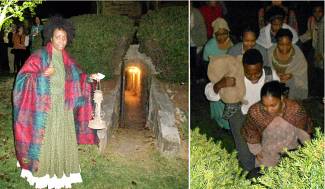Collection Name
About
Samuel Denson’s Last Run
On November 6, 2016 an event was held at the Emmanuel Episcopal Church in Cumberland to celebrate the 152nd Anniversary of the Maryland Emancipation. The event was jointly sponsored by the Allegany College of Maryland NAACP Club, Frostburg State University’s African American Studies Program, the Emmanuel Episcopal Church, the Jane Gates Heritage House and several others.
It had been on January 1, 1863 that President Abraham Lincoln signed the Emancipation Proclamation, declaring "that all persons held as slaves" within the rebellious states "are, and henceforward shall be free." For several states, such as Maryland, slavery remained in place. Thus on November 1, 1864, more than a year before slavery would be abolished nationwide with the passage of the 13th Amendment to the U.S. Constitution, Maryland amended its constitution to prohibit slavery.
Based upon oral histories and folklore passed down from one generation to another, Samuel Denson was a runaway slave from Mississippi who came to Cumberland as a young man in the 1850’s. He had been involved in the Underground Railroad. Upon arriving in Cumberland he was given the position of sexton at Emmanuel Episcopal Church, and as such worked with Reverend Buel in providing a safe passage north for escaping slaves. Runaways would stay hidden in buildings at the foot of the church hill during the day. At one o'clock in the morning Denson would ring the church bell alerting them to begin the climb. This route included using the tunnels that run beneath the church.
The interactive dramatization held at Emmanuel portrayed these events and the history of Emancipation on the state as well as national level. The packed house was also presented with a ringing of the church bells which was a signal for the escaping slaves to make their way up from river and C&O Canal to the church tunnels, an acknowledgement of the local descendants of that period, a trip through the tunnels and Gospel music of that era.
For more detailed information on Samuel Denson and the Underground Railroad, see "Emmanuel’s Underground Railroad" which appears elsewhere on this website. The photographs depict one of the Underground Railroad conductors (portrayed by Lakeal Tootie Ellis) directing the escaping slaves into the tunnels.
Photographs by Albert L. Feldstein
